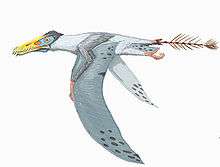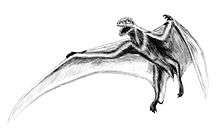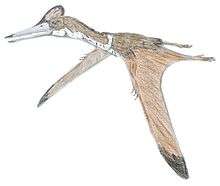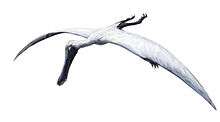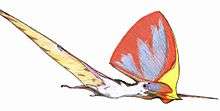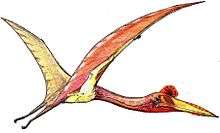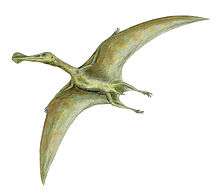Cimoliopterus
Cimoliopterus is a genus of pterodactyloid pterosaur from the Cretaceous of England, United Kingdom and Texas, United States.[1]
| Cimoliopterus | |
|---|---|
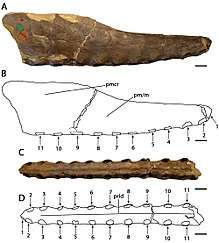 | |
| Holotype rostrum tip of C. cuvieri (specimen NHMUK PV 39409) shown from the right side and below | |
| Scientific classification | |
| Kingdom: | Animalia |
| Phylum: | Chordata |
| Order: | †Pterosauria |
| Suborder: | †Pterodactyloidea |
| Clade: | †Lanceodontia |
| Clade: | †Ornithocheirae |
| Clade: | †Targaryendraconia |
| Family: | †Cimoliopteridae |
| Genus: | †Cimoliopterus Rodrigues & Kellner, 2013 |
| Type species | |
| †Pterodactylus cuvieri Bowerbank, 1851 | |
| Species | |
| |
| Synonyms | |
|
List
| |
The type species, Cimoliopterus cuvieri, was previously considered parts of several different genera depending on author, but received its own genus in 2013.[2]
History of discovery
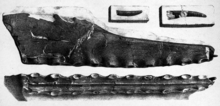
In 1851, James Scott Bowerbank named and described some remains found in a chalk pit at Burham near Maidstone in Kent, as a new species of Pterodactylus: Pterodactylus cuvieri. The specific name honors Georges Cuvier. The same pit had generated remains of Pterodactylus giganteus.[3]
In 1869, Harry Govier Seeley renamed the species into Ptenodactylus cuvieri,[4] at the same time disclaiming the name which makes it invalid by modern standards. In 1870, Seeley had realised that the generic name Ptenodactylus had been preoccupied and renamed the species into Ornithocheirus cuvieri.[5] In 1874 Richard Owen renamed it into Coloborhynchus cuvieri;[6] in 2001 David Unwin into Anhanguera cuvieri.[7]
In 1919 and 1922, the Austrian naturalist Gustav von Arthaber lamented that the scientific literature had accepted the many Ornithocheirus names that had only been mentioned in a catalogue made by Seeley for the benefit of students. In his opinion names were worthless without an illustration of the specimens they were based on, or better still a complete restoration of the relevant skeleton. For this reason, he provided a drawing of the skull of Ornithocheirus cuvieri, one of the few species for which the known jaw material proved its validity.[8]
In 2013, Taissa Rodrigues and Alexander Wilhelm Armin Kellner created a separate genus: Cimoliopterus. The generic name combines Κιμωλία, Kimolia, the white clay of the island Kimolos (kimolia means "chalk" in New Greek) with a Latinised Greek πτερόν, pteron, "wing". The type species remains Pterodactylus cuvieri, the resulting combinatio nova, new combination name, is Cimiliopterus cuvieri.[2]
The holotype, NHMUK PV 39409, had been found in a layer of the Chalk Formation dating from the Cenomanian-Turonian. It consists of a snout fragment. It was originally preserved with a single tooth in the right snout tip, but this had disappeared by 2007.[2]

Ornithocheirus brachyrhinus Seeley 1870 and Pterodactylus fittoni Owen 1859 share several features with C. cuvieri, and it can therefore not be excluded that they are the same taxon. However, they are too incomplete to be definitely referred to C. cuvieri, so were by Rodrigues and Kellner considered nomina dubia.[2]
In 2015, a new species was described: Cimoliopterus dunni, which was discovered in the Britton Formation on the north-central Texas, United States, and its fossil remains date to the Cenomanian stage, of the early Late Cretaceous. The holotype specimen consists in a partial rostrum with the 26 preserved alveoli and bears a thin premaxillary crest that begins over the fourth alveoli, the tip of the snout is blunt and the rostrum have an angle of 45° respect to the anterior part of the palate. This find extends the distribution of the genus to North America and shows that the pterosaur faunas from Europe and North America still had contact during the middle Cretaceous. The phylogenetic analysis included in the description of this species indicates that Cimoliopterus is a basal pteranodontoid closely related with Aetodactylus, which has also been found in Cenomanian strata from Texas.[1]
Description
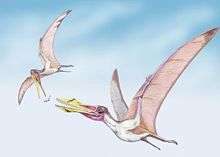
Bowerbank, extrapolating from the remains of P. giganteus, estimated a wingspan for P. cuvieri of about 5.029 meters (16.50 ft), making it the largest flying animal, extinct or extant, known in 1851.[3] This claim at the time was met with considerable scepticism, though today, larger pterosaurs are known to have existed.[9]
In 2013, Rodrigues and Kellner established two unique derived traits, autapomorphies, for Cimoliopterus, making it unique among its relatives: its crest is placed far back on the premaxilla, at the level of the seventh tooth pair, but begins before the fenestra nasoantorbitalis, the large skull opening; there is a density of three teeth per three centimetres at the front of the upper jaw and of two teeth at the back of the jaw. Furthermore, Cimoliopterus shows a unique combination of by themselves not unique traits: the snout has a crest; the ridge on the midline of the palate, at the front reaches the level of the third tooth pair; the palate is curved upwards; there is no expansion of the jaw at the front; the second and third tooth pairs are about equally large and larger than the fourth tooth pair; to the rear the distance between the teeth gradually increases.[2]
Classification

Cimoliopterus was by Rodrigues and Kellner (and Myers in 2015) assigned to the Pteranodontoidea, in an uncertain position (incertae sedis). Cladistic analyses indicated a position in the evolutionary tree above Istiodactylus but below a polytomy formed by more derived forms.[2]
In 2018, Jacobs et al. performed a phylogenetic analysis where they placed Cimoliopterus within the family Ornithocheiridae, as the sister taxon of Camposipterus. They published their analysis in 2019.[11] Later that year however, Pêgas et al. reassigned Cimoliopterus to the newly named clade Targaryendraconia, more specifically to its own family, the Cimoliopteridae, and sister taxon to both Aetodactylus and Camposipterus.[12]
|
Topology 1: Jacobs et al. (2019).[11]
|
Topology 2: Pêgas et al. (2019).[12]
|
References
- Myers, Timothy S. (2015). "First North American occurrence of the toothed pteranodontoid pterosaur Cimoliopterus". Journal of Vertebrate Paleontology. 35: e1014904. doi:10.1080/02724634.2015.1014904.
- Rodrigues, T.; Kellner, A. (2013). "Taxonomic review of the Ornithocheirus complex (Pterosauria) from the Cretaceous of England". ZooKeys. 308: 1–112. doi:10.3897/zookeys.308.5559. PMC 3689139. PMID 23794925.
- Bowerbank, J.S. (1851). "On the pterodactyles of the Chalk Formation" (PDF). Proceedings of the Zoological Society of London. 19: 14–20. doi:10.1111/j.1096-3642.1851.tb01125.x.
- Seeley, H.G., 1869, Index to the fossil remains of Aves, Ornithosauria, and Reptilia, from the Secondary System of Strata arranged in the Woodwardian Museum of the University of Cambridge. Deighton, Bell and Co., Cambridge, xxiii + 143 pp
- Seeley, H.G., 1870, The Ornithosauria: an elementary study of the bones of pterodactyls, made from fossil remains found in the Cambridge Upper Greensand, and arranged in the Woodwardian Museum of the University of Cambridge. Deighton, Bell, and Co., Cambridge, xii + 135 pp
- Owen, R. 1874, Monograph on the fossil Reptilia of the Mesozoic Formations. Palaeontographical Society, London, 14 pp
- Unwin, D.M. (2001). "An overview of the pterosaur assemblage from the Cambridge Greensand (Cretaceous) of Eastern England". Mitteilungen aus dem Museum für Naturkunde in Berlin, Geowissenschaftliche Reihe. 4: 189–221. doi:10.1002/mmng.4860040112.
- Von Arthaber, G. (1922). "Über Entwicklung, Ausbildung und Absterben der Flugsaurier". Paläontologische Zeitschrift. 4: 1–47.
- Witton, M.P., Martill, D.M. and Loveridge, R.F. (2010). "Clipping the Wings of Giant Pterosaurs: Comments on Wingspan Estimations and Diversity". Acta Geoscientica Sinica. 31: 79–81.CS1 maint: uses authors parameter (link)
- Von Arthaber, G. (1919). "Studien über Flugsaurier auf Grund der Bearbeitung des Wiener Exemplars von Dorygnathus banthensis Theod Sp". Denkschriften der königlichen Akademie der Wissenschaften. Mathematisch-Naturwissenschaftliche Klasse. 97: 391–464.
- Jacobs, M.L., Martill, D.M., Ibrahim, N., Longrich, N. (2019). "A new species of Coloborhynchus (Pterosauria, Ornithocheiridae) from the mid-Cretaceous of North Africa" (PDF). Cretaceous Research. doi:10.1016/j.cretres.2018.10.018.CS1 maint: uses authors parameter (link)
- Rodrigo V. Pêgas, Borja Holgado & Maria Eduarda C. Leal (2019) On Targaryendraco wiedenrothi gen. nov. (Pterodactyloidea, Pteranodontoidea, Lanceodontia) and recognition of a new cosmopolitan lineage of Cretaceous toothed pterodactyloids, Historical Biology, doi:10.1080/08912963.2019.1690482

